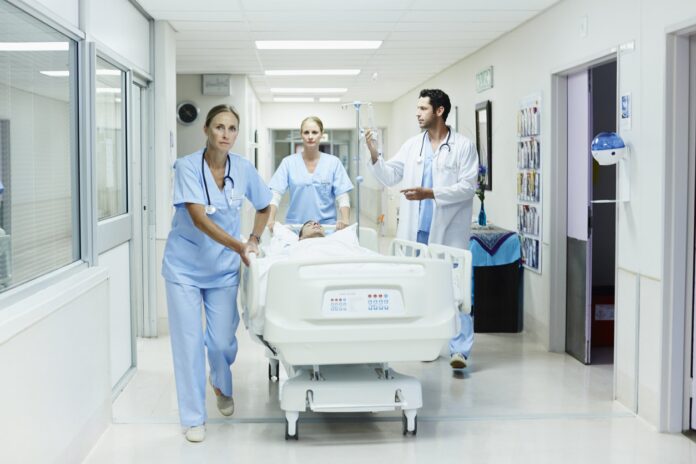Ventilators are hospital bedside machines that assist with two critical functions: getting enough oxygen into the bloodstream and clearing out carbon dioxide, which can build up when the patient is too weak or sick to move air in and out of the lungs. The decision to hook a patient up to one is made when it is clear that the lungs have become too inflamed or injured to do those functions on their own and when steps that are less invasive, like an oxygen mask placed over a person’s nose and mouth, fail to deliver what the patient needs.
“Through different types of settings, we’re able to sync up with how the patient is breathing and assist them with extra pressure, extra volume, extra flow using that mechanical ventilator,” Singer said.
The tube in the windpipe makes it nearly impossible for patients to talk because it passes through their vocal cords, Singer said. If patients are awake and alert, doctors work to communicate with their patients in other ways, from a simple pen and paper to computer interfaces, he added.Many patients are given pain management medications while they are on ventilators, but if possible, doctors try to limit sedation so the patient can be aware of what is happening.
“The level of needing sedation is variable from person to person. All else being equal, we want patients, while they are on a mechanical ventilator, particularly after that initial placement of the breathing tube, to be as awake as possible,” Singer said.
Those who receive ventilators are typically the sickest patients in the hospital, and the decision to put them on ventilators is often the last resort to save their lives. Patients do not always recover, and there is a possibility that they acquire a case of pneumonia that they did not have before being put on the ventilator, Rizzo said. Their lung injuries can also be exacerbated if ventilators are not on exactly the right setting. (There are also patients who are on ventilators for reasons other than respiratory issues, such as those with neuromuscular diseases, including amyotrophic lateral sclerosis, or Lou Gehrig’s disease, or patients with brain damage.)With illnesses like the coronavirus, which is spread through respiratory droplets, there are risks associated with ventilators for health care providers, too.
The ventilator is a closed system, so once the patient is on the ventilator, there are not necessarily extra dangers to being around them. But the process of placing the breathing tube in, called intubation, can expose health care workers to the illness through aerosols that escape from the patient’s airway. These minuscule droplets can be inhaled in the absence of proper personal protective equipment, such as N95 respirator masks, which are also in short supply around the world.”There are things in the hospital that generate aerosols, very, very fine droplet particles that can still carry the virus, can linger in the air for much longer than the droplet, and we think poses a much higher risk,” Singer said.
The time a patient stays on a ventilator can vary from days to weeks, experts said. At the Tulane Medical Center in New Orleans, coronavirus patients have typically been on ventilators for one or two weeks, said Dr. Joshua Denson, a pulmonary medicine and critical care physician.”Very few get better quickly,” meaning in fewer than three days, Denson said.
Once a patient no longer needs a ventilator, the tubing connected to it is thrown out, and the ventilator is used for the next patient after a thorough cleaning.
But without enough ventilators in their stockpiles, hospitals could be overwhelmed. In Italy, the European center of the coronavirus outbreak, doctors have been forced to make heart-wrenching decisions about who receives ventilators and who does not as their hospitals overflow with coronavirus patients. Fearing a similar scenario could happen in the United States, Gov. Andrew Cuomo has pleaded for federal assistance securing more ventilators for New York, which has over 30,000 coronavirus cases, more than any other state
The ventilators themselves are only part of what patients with significant breathing difficulties need, said Dr. David Zaas, president of Duke Raleigh Hospital and associate professor of pulmonary and critical care medicine at the Duke University School of Medicine. They also need highly trained staff monitoring them around the clock in the intensive care unit.
“We could make a million ventilators, but do we have enough respiratory therapists that are trained to care for patients on ventilators, and do we have enough nurses that are trained in caring for patients that are critically ill?” he said.
The U.S. has about 160,000 ventilators, according to a 2018 analysis from the Johns Hopkins Center for Health Security, a number that experts have warned will not suffice if social distancing measures and other attempts to flatten the curve of the disease do not work quickly enough.
“We are all, as part of our emergency management planning, exploring how we would do things which would not be our typical care,” he added. “But in atypical times, we need to come up with creative and innovative solutions to try to save lives.”
Summary:
This article addressed the dire need for ventilators among covid-19 patients. Because so many were infected there became more people in a critical state than normal. Doctors began putting two patients on one machine. Or even worse some patients died because there wasn’t any ventilators to put them on. If more than two patients were able to share one machine than maybe they could have survived. I think another solution could be installing ventilators into the beds of patients so they are able to travel around and be put anywhere in the hospital without the nuisance of a stationary ventilator.




